Related Research Articles

A suburb is an area within a metropolitan area which is predominantly residential and within commuting distance of a large city. Suburbs can have their own political or legal jurisdiction, especially in the United States, but this is not always the case, especially in the United Kingdom, where most suburbs are located within the administrative boundaries of cities. In most English-speaking countries, suburban areas are defined in contrast to central city or inner city areas, but in Australian English and South African English, suburb has become largely synonymous with what is called a "neighborhood" in the U.S. Due in part to historical trends such as white flight, some suburbs in the United States have a higher population and higher incomes than their nearby inner cities.
David Holmgren is an Australian environmental designer, ecological educator and writer. He is best known as one of the co-originators of the permaculture concept with Bill Mollison.

William Jaird Levitt was an American real-estate developer and housing pioneer. As president of Levitt & Sons, he is widely credited as the father of modern American suburbia. In 1998 he was named one of Time Magazine's "100 Most Influential People of the 20th Century."
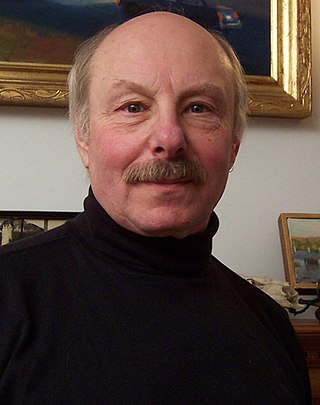
James Howard Kunstler is an American writer, social critic, public speaker, and blogger. He is best known for his books The Geography of Nowhere (1994), a history of American suburbia and urban development, The Long Emergency (2005), and Too Much Magic (2012). In The Long Emergency he imagines peak oil and oil depletion resulting in the end of industrialized society, forcing Americans to live in smaller-scale, localized, agrarian communities. In World Made by Hand he branches into a speculative fiction depiction of this future world.

Suburbanization, also spelled suburbanisation, is a population shift from historic core cities or rural areas into suburbs. Most suburbs are built in a formation of (sub)urban sprawl. As a consequence of the movement of households and businesses away from city centers, low-density, peripheral urban areas grow.Proponents of curbing suburbanization argue that sprawl leads to urban decay and a concentration of lower-income residents in the inner city, in addition to environmental harm.
Urban decay is the sociological process by which a previously functioning city, or part of a city, falls into disrepair and decrepitude. There is no single process that leads to urban decay.
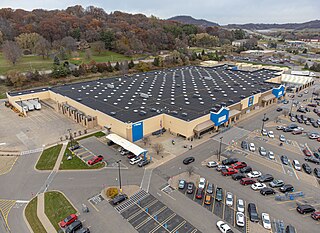
A big-box store, a hyperstore, a supercenter, a superstore, or a megastore is a physically large retail establishment, usually part of a chain of stores. The term sometimes also refers, by extension, to the company that operates the store. The term "big-box" references the typical appearance of buildings occupied by such stores.

"Pleasant Valley Sunday" is a song by Gerry Goffin and Carole King, recorded and released by the Monkees in the summer of 1967. Inspired by their move to West Orange, New Jersey, and named for a street there, Goffin and King wrote the song about their dissatisfaction with life in the suburbs.

University Town Center, formerly New Town Center, is located in Hyattsville, Prince George's County, Maryland, United States. It was a planned urban center designed by Edward Durell Stone and located on a 105-acre (0.42 km2) parcel at the intersection of Belcrest Road and East-West Highway and across from the then new Prince George's Plaza. The initial construction on this development took place in 1963–64; its buildings are listed on the National Register of Historic Places. A second phase commenced after the opening of the Hyattsville Crossing station, Washington Metro rapid transit station in 1993.

Criticism of suburbia dates back to the boom of suburban development in the 1950s and critiques a culture of aspirational homeownership. In the English-speaking world, this discourse is prominent in the United States and Australia being prevalent both in popular culture and academia.

Peter Calthorpe is a San Francisco–based architect, urban designer and urban planner. He is a founding member of the Congress for New Urbanism, a Chicago-based advocacy group formed in 1992 that promotes sustainable building practices. For his works on redefining the models of urban and suburban growth in America Calthorpe has been named one of twenty-five ‘innovators on the cutting edge’ by Newsweek magazine.
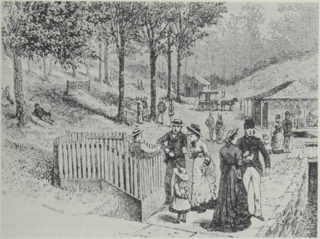
Ponce de Leon Springs was a mineral spring in Atlanta, Georgia, in the United States. The spring was a popular tourist destination from the mid-1800s through the early 1900s. Around the turn of the century, the land surrounding the spring was developed into an amusement park. By the 1920s, the amusement park was demolished, and the area was developed for industrial and, later, commercial properties.
A large number of books and articles have been written on the subject of suburbs and suburban living as a regional, national or worldwide phenomenon. This is a selected bibliography of scholarly and analytical works, listed by subject region and focus.
Midtown Centre is a business park located in the Jacksonville, Florida neighborhood of St. Nicholas. The site contains 31 buildings and was developed by Ira M. Koger. Opening in 1957 as the Koger Center, the facility is credited with being the first suburban office park. It is now owned by D Group Equities.
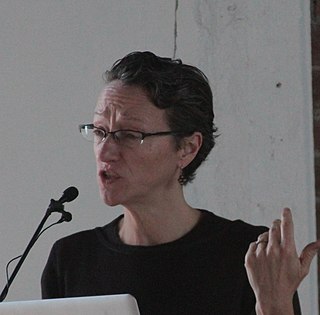
Ellen Dunham-Jones is an architectural educator and urbanist best known for her work on re-educating the public how to interact with their environment. She is also an authority on suburban redevelopment.
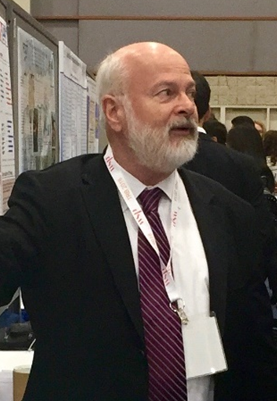
Arthur C. Nelson is an American urban planner, researcher and academic. He is Professor of Urban Planning and Real Estate Development at the University of Arizona.
Richard M. Sommer is a Professor of Architecture and Urbanism and the Director of the Global Cities Institute at the John H. Daniels Faculty of Architecture, Landscape, and Design, University of Toronto. From 2009 until 2020, he was the Dean of the Daniels Faculty. Sommer was born in Philadelphia, and now resides in Toronto, Canada. Trained as an architect and urbanist, Sommer is a leader in architectural education and is a designer and scholar of the built environment.

Sonia Anguelova Hirt is a professor of Landscape Architecture and Planning and dean in the College of Environment + Design at the University of Georgia.
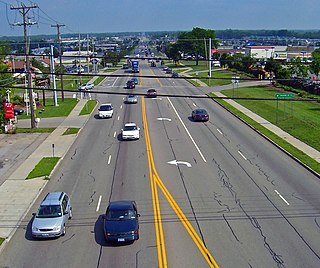
A stroad is a type of street–road hybrid. Common in the United States and Canada, stroads are wide arterials that often provide access to strip malls, drive-throughs, and other automobile-oriented businesses. Stroads have been criticized by urban planners for their safety issues and inefficiencies. While streets serve as a destination and provide access to shops and residences at safe traffic speeds, and roads serve as a high-speed connection that can efficiently move traffic at high speed and volume, stroads are often expensive, inefficient, and dangerous.
Urban retrofitting is a combination of policies and phenomena done with the goal of undoing or remedying the effects of urban sprawl. The phenomena of adaptive reuse and infill development to combat sprawl are key to this. It often follows the new urbanist school of thought, which aims to undo the sprawl and flight from urbanized areas that occurred in the US and Canada after WWII.
References
- ↑ "June Williamson". ssa.ccny.cuny.edu. Archived from the original on 2021-01-17. Retrieved 2021-02-03.
- ↑ "The People the Suburbs Were Built for Are Gone". www.vice.com. 21 January 2021. Archived from the original on 3 February 2021. Retrieved 3 February 2021.
- ↑ Lasky, Julie (October 16, 2020). "Like It or Not, the Suburbs Are Changing". The New York Times. Archived from the original on February 3, 2021. Retrieved February 3, 2021– via NYTimes.com.
- ↑ Dunham-Jones, Ellen; Williamson, June (13 April 2014). "Gentrify Those Suburban Parking Lots". The New York Times. Archived from the original on 11 August 2024. Retrieved 3 February 2021.